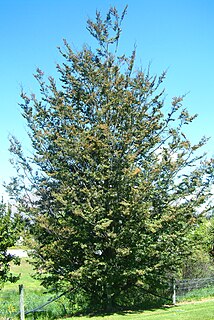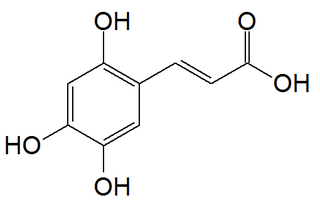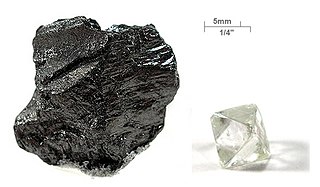
Rooibos, meaning 'red bush'; is a broom-like member of the plant family Fabaceae that grows in South Africa's fynbos.

Nothofagus, also known as the southern beeches, is a genus of 43 species of trees and shrubs native to the Southern Hemisphere in southern South America and Australasia. The species are ecological dominants in many temperate forests in these regions. Some species are reportedly naturalised in Germany and Great Britain. The genus has a rich fossil record of leaves, cupules, and pollen, with fossils extending into the late Cretaceous period and occurring in Australia, New Zealand, Antarctica, and South America. In the past, they were included in the family Fagaceae, but genetic tests revealed them to be genetically distinct, and they are now included in their own family, the Nothofagaceae.

Safranal is an organic compound isolated from saffron, the spice consisting of the stigmas of crocus flowers. It is the constituent primarily responsible for the aroma of saffron.
In 1904, Benjamin Ginsberg, a Russian immigrant and pioneer in the Cederberg region of the Cape, South Africa, became the first to trade Rooibos tea and cultivate it under production.

Nothofagus fusca, commonly known as red beech is a species of southern beech, endemic to New Zealand, where it occurs on both the North Island and South Island. Generally it is found on lower hills and inland valley floors where soil is fertile and well drained. In New Zealand the species is called Fuscospora fusca.

Nothofagus solandrivar.solandri, commonly called Black beech, is a variety of the tree species Nothofagus solandri, endemic to New Zealand. Black beech occurs on both the North and the South Island at low altitudes up to the mountains. The other variety of N. solandri is called Mountain beech or Nothofagus solandri var. cliffortioides, and grows at higher altitudes than black beech. In New Zealand the taxon is called Fuscospora solandri.

Nothofagus alessandrii (ruil) is a species of plant in the family Nothofagaceae, commonly known as the southern beeches. It is endemic to Chile, occurring chiefly in the Chilean matorral ecoregion. It is threatened by habitat loss. The species is protected within Los Ruiles National Reserve.

Aspalathin is a C-linked dihydrochalcone glucoside found in rooibos tea, a herbal tea prepared from the South African rooibos plant, Aspalathus linearis (Fabaceae).

Crotalarieae is a tribe of flowering plants belonging to the bean family, Fabaceae. It includes rooibos (Aspalathus linearis), harvested for sale as a tisane.

tert-Amyl alcohol (TAA), systematic name 2-methylbutan-2-ol (2M2B), is a branched pentanol.

Aspalathus is a genus of flowering plants in the legume family, Fabaceae. The yellow flowers and spiny habit of some species have suggested a resemblance to Ulex europaeus, the thorny "English gorse" Accordingly, "Cape Gorse" has been proposed as a common name although the resemblance is largely superficial; for instance, gorse is thorny, whereas Aspalathus species are variously spiny or unarmed. The genus belongs to the sub family Faboideae. There are over 270 species, mainly endemic to southwestern fynbos regions in South Africa, with over fifty occurring on the Cape Peninsula alone. The species Aspalathus linearis is commercially important, being farmed as the source of Rooibos tea.
Monopetalotaxis candescens is a moth of the family Sesiidae. It is known from South Africa.
Monopetalotaxis doleriformis is a moth of the family Sesiidae. It is known from South Africa.

Nothofagus solandri var. cliffortioides, commonly called mountain beech, is a species of Southern beech tree and is endemic to New Zealand. Mountain beech grows in mountainous regions at high altitudes. In New Zealand the taxon is called Fuscospora cliffortioides. Nothofagus solandri var. cliffortioides occupies a wider range of habitat than any other New Zealand tree species and it shows a corresponding range of life form, seeding habits, regenerative patterns, growth habits, growth rates, stand replacement and mortality patterns.

Boletopsis nothofagi is a fungus in the family Bankeraceae. The fungus forms grey fruit bodies that grow in clusters. Like all species of Boletopsis, it has a porous spore-bearing surface on the underside of the cap, but differs from other species of Boletopsis by having characteristics such as elongated spores and a green discoloration when stained with potassium hydroxide. Boletopsis nothofagi is endemic to New Zealand and has a mycorrhizal association with red beech. It is unknown when exactly the fungus forms its fruit body, but it has so far been found solely in May, during autumn in the Southern Hemisphere.

2,4,5-Trihydroxycinnamic acid is a hydroxycinnamic acid found in rooibos tea. cis-2,4,5-Trihydroxycinnamic acid can be isolated from seeds of Alisma orientale.
Cortinarius cucumeris is a basidiomycete fungus of the genus Cortinarius native to New Zealand, where it grows under Nothofagus.
Rooibos wine is a variety of wine in which wood from the rooibos and honeybush plants is used instead of the traditional oak wood during the maturation phase. It has its origin in the Western Cape, South Africa. The wine has a unique flavor component and due to the anti-oxidative effect of the plants can be produced without the use of sulfur dioxide.
Amanda C. Swart is a South African biochemist who holds a professorship in biochemistry at Stellenbosch University. She is known for her research on rooibos, a herbal tea popular in South Africa, and has been funded by the South African Rooibos Council in her research. Her research has suggested that drinking rooibos may lower stress through the effects of two compounds in it, aspalathin and nothofagin, which block the production of stress hormone cortisol. She has also suggested that rooibos may have beneficial effects for prostate cancer by blocking another hormone, dihydrotestosterone.
















